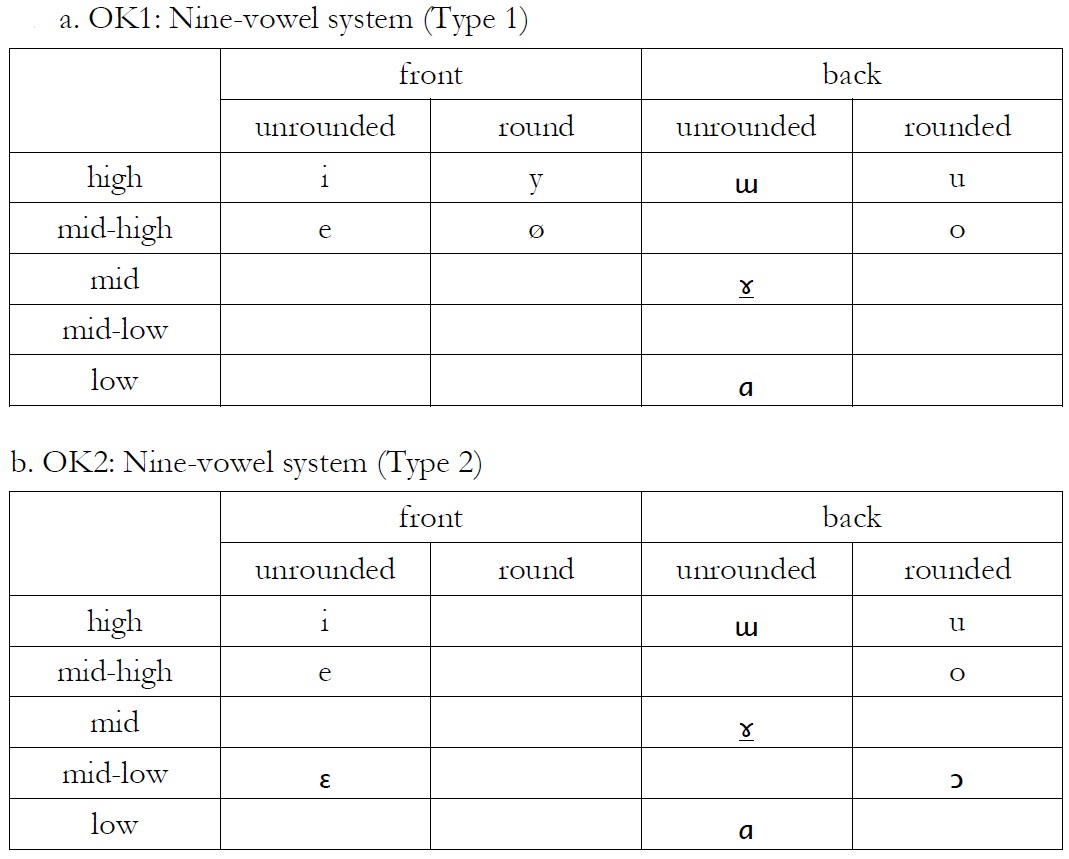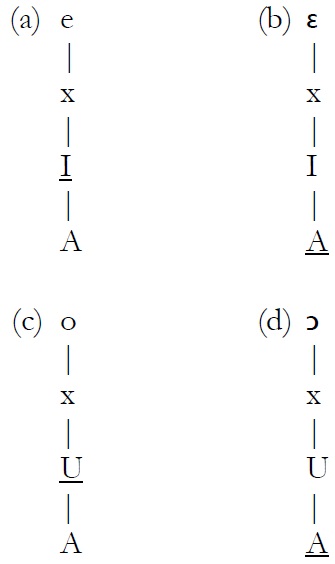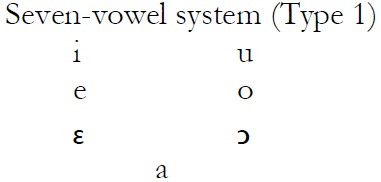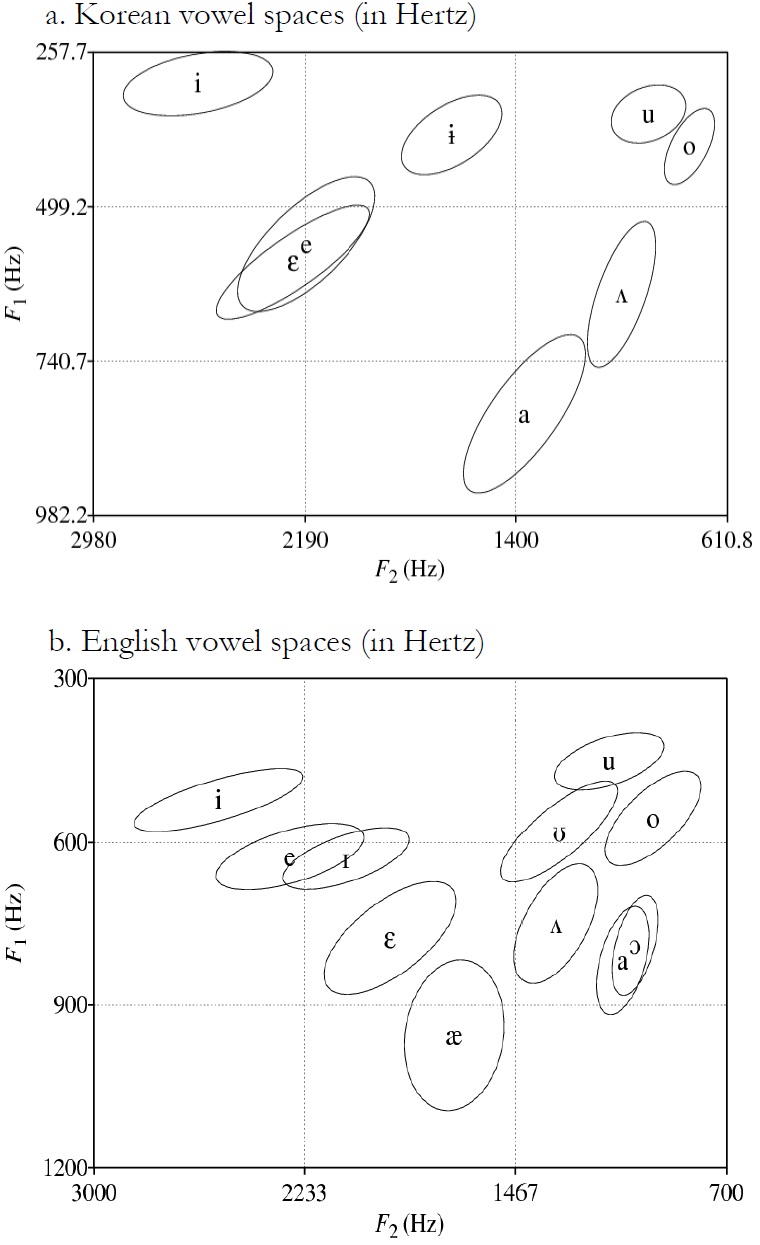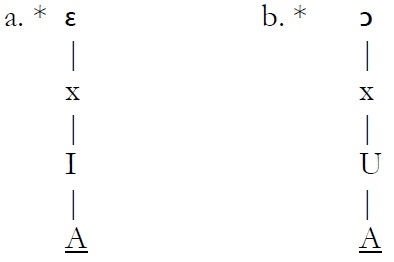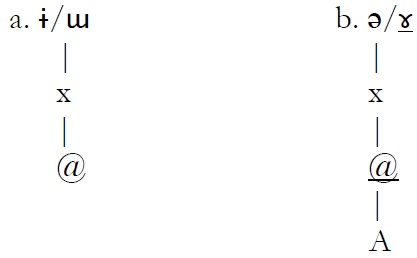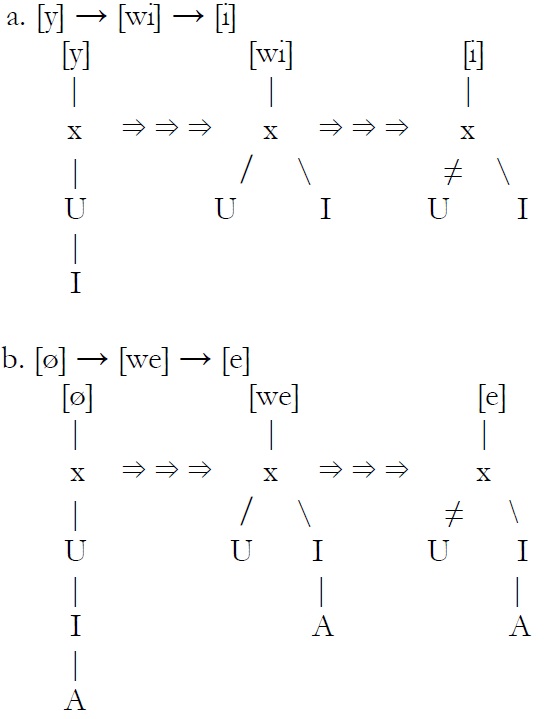


This article discusses the various vowel systems of the Korean language, with consideration of the element theory of Government phonology. Korean vowel systems are different from one another, according to region and/or age variations. The differences are mainly in (i) whether or not the two non-high front peripheral vowels undergo neutralization, and (ii) whether or not the system allows the two front interior vowels. Overall, Korean vowel systems are shifting toward a reduction in the number of vocalic items.
It has been claimed that the shifts of the segmental system generally arise from the structural factors within the system. That is, the problem of phonological structure that can be seen in a vowel system is mainly due to the violation of the principle of vowel dispersion.
However, we claim that the case of Korean is somewhat different. As for the evolution of Korean vowel systems, we claim that it has not occurred by violating the principle of vowel dispersion, but rather by the tendency of constraint; Korean does not allow two different dependency relations between elements contained in a segment. More concretely, the constraint that A-head non-high front and back peripheral vowels are not allowed is emerging as a trend in Korean phonology. Another trend in Korean is the constraint whereby the fusion of the two elements I and U are not permitted. The former excludes a vowel from the front peripheral space, and due to the latter the two vowels /y/ and /ø/ are not present in the list of Korean vowels.
In this paper, we discuss various Korean vowel systems in the framework of the element theory of Government phonology (henceforth, GP) originally proposed by Kaye, Lowenstamn, and Vergnaud (1985). We will show that this approach accounts for the shifts of the Korean vowel system and also determines the directions of the shifts. That is, the element theory can explain which vocalic segments in the Korean language undergo change, and why and how they are changed.
It can be said that the sound systems of human languages are largely well organized and thus remarkable regularities are found in them. Hence, most phonological theories attempt to explain the regularities in the systems of vowels and consonants in their own way. With respect to the changes of the Korean vowel system, we will show how this process derives from the constraints of the element theory.
We acknowledge that vowel systems are different from consonant systems in several ways. First, in most languages, the number of vowels is less than that of consonants. Second, vowel systems differ from consonantal systems in that the former are less multidimensional than the latter, in the sense of segmental composition. For example, following the UPSID, the UCLA Phonological Segment Inventory Database (Maddieson, 1984; Maddieson & Precoda, 1990), fourteen different kinds of stop series in manners of articulation such as plain voiceless and plain voiced are found in 317 sample languages (henceforth, UPSID317 , and, though very rare, there are languages that have six stop series among them.2 However, it is hardly possible to see languages in which more than two vowels, namely, the rounded and unrounded vowels, are found in a single vowel space. Third, the tendency of the composition of vowel systems is more predictable than that of consonantal systems. That is, three-vowel systems tend to be composed of /a/, /i/ and /u/; five-vowel systems tend to be composed of these three vowels plus two more vowels /e/ and /o/; and so on. In this sense, the statement that languages “build up” their phonologies in an ordered fashion (Gussenhoven & Jacobs, 2004) fits vowel systems more than consonantal systems. For this reason, research on vowel systems is much more common than those on consonantal systems, and most phonological theories concentrate on the configuration of these vowel systems.
On the other hand, it is said that the shifts of segmental systems generally arise from the structural factors within the system. In other words, the shifts of vowel systems are the results of adjustment or compensation for the so-called ‘defective’ vowel systems (Disner, 1984; Kwak, 2003) that are either of asymmetry of the unbalanced system, ill-spaced in the sense of vowel dispersion, or the socalled ‘missing vowel’ in a particular phonetic space and so on. However, we claim that there are cases where the causes that bring shifts or evolution of a vowel system in a language are not based on the structural defectiveness of a given language, but rather on the tendencies or the course of a trend. Of course, these tendencies are also realized as the constraints that govern the segmental systems. We will see that the evolution of contemporary Korean vowel systems falls into this case.
In this article, we will analyze variations of the Korean vowel systems that are different according to age and/or region, and interpret phonological meaning in them based on element theory. More concretely, we will show why certain vowels undergo segmental change, such as neutralization or diphthongization, whereas others remain unchanged, and what the criteria for such differences are.
The remaining sections of this article are organized as follows: In section 2, we will first present seven different variations that can be seen in the course of the evolution of Korean vowel systems.3 We will see that the vowels /y/ and /ø/ are eliminated from the vowel lists, the two vowels /e/ and / ɛ / are neutralized to the mid-high vowel /e/ (or the mid vowel /e/), and / ɯ / merges with /u/ or /ɤ/ in certain dialects. /ɤ/, the mid back unrounded vowel, in IPA (International Phonetic Alphabet) lies across two or three phonetic spaces according to its length, and thus is pronounced either as the mid-high vowel /ɤ/ or the mid-low vowel /ʌ/ as is also shown in this section.4 A brief introduction of the element theory is also given in this section. In section 3, we analyze the segmental changes in vowel systems that can be seen in the course of system shifts in the Korean of South and North Korea (henceforth, “South Korean” and “North Korean,” respectively). Finally, in section 4, we conclude the discussion and suggest directions for further research.
2We borrow notation such as UPSID317 from Schwartz, Boë, and Abry (2007). 3In this paper, following UPSID (Maddieson, 1984) and Heo (2011), we assume that the vowels of Korean are classified as having one of five different heights: high, mid-high, mid, mid-low, or low. We would like to note that vowels described as being ‘mid’ lie between the mid-high and midlow positions. 4Many Korean phonologists use / ɨ / and /ə/ rather than / ɯ / and /ɤ/, not because of the accuracy of the sounds but because of the convention , while still classifying them as back vowels. The same is true in the case of / ɑ /, thus, it is normally transcribed as /a/.
2. DATA AND THEORETICAL CONSIDERATIONS
2.1. ASPECTS OF KOREAN VOWEL SYSTEMS
Korean mainly exhibits seven different vowel systems, with the number of vowels varying from six to ten. Many native speakers of Korean differ in production and/or perception of the number of vowels in its inventory, according to age and/or region. First, some phonologists (Huh, 1964, 1982; Lee, 1976; Cho, 2005) assume that people speak with ten vowels, / ɑ , i, u, e, ɛ , o, ɯ, ɤ, y, ø/, as can be seen in (1) below. This system contains six peripheral vowels (three front and two back vowels and one low vowel) and four interior vowels (two vowels each at front and back).5 This system is regarded as the standard pronunciation of Korean monophthongs, and it is said that this system is spoken by the older generation or elderly group in Central Korea, which includes Seoul. However, now, it is considered too conservative, and, thus, it is very difficult to find people speaking with this system. Note that all the other systems of South Korea are derived from this conservative system (henceforth, CK). The only exception is the system of Jeju Island, which we will discuss in more detail later.
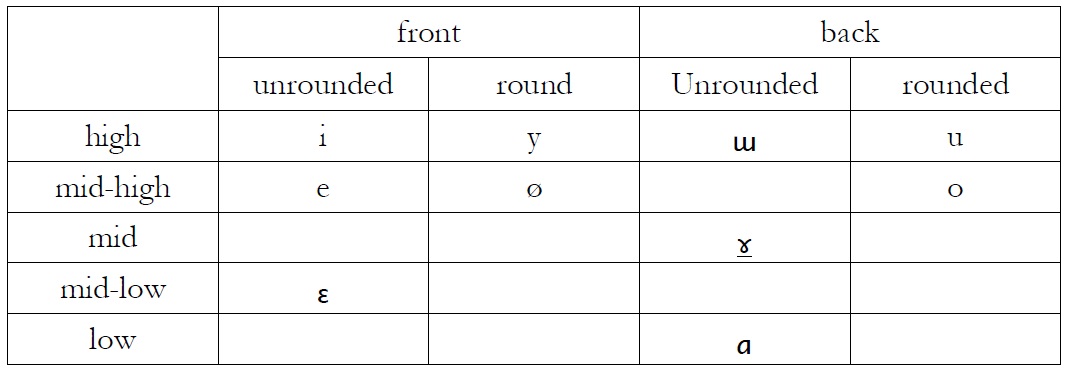
CK: Ten-vowel system
It should be mentioned that the mid back unrounded vowel, unlike other vowels, has two different realizations according to its length. Generally speaking, the long one is realized as the mid-high vowel [ɤ:], corresponding to its front counterpart /e/. We see that this vowel frequently alternates with the high back unrounded vowel / ɯ / in daily conversation, as in the word
We have two more systems that are spoken by older people, namely OK1 and OK2, and both of which consist of nine vowels, as is shown in (2a)and (2b) below.
The system in (2a) is spoken in the southwest region of the Korean Peninsula, and the one in (2b) is spoken on Jeju Island. Although these two systems commonly consist of nine vowels, the items are somewhat different from each other. The system OK1, consisting of / ɑ , i, u, e, o, ɯ , ɤ , y, ø/, has five peripheral vowels including one low peripheral vowel, and two interior vowels each at front and back. This system differs from the CK system in having only one non-high front peripheral vowel /e/ by the process of neutralization.
On the other hand, the system OK2, consisting of /ɑ, i, u, e, o, ɛ, ɔ, ɯ, ɤ/, contains seven peripheral vowels including one low peripheral vowel, and two interior vowels at the back. The difference between the CK system and this system is that the former lacks the vowel / ɔ /, whereas the latter lacks /y/ and /ø/. In this system and other systems where /y/ and /ø/ are excluded, the two vowels are realized as the diphthongs [wi] and [we] or simply [i] and [e]. For instance, the words
Let us now consider the system spoken by the relatively younger groups. This system (henceforth, YK) consists of seven vowels as shown in (3) below.
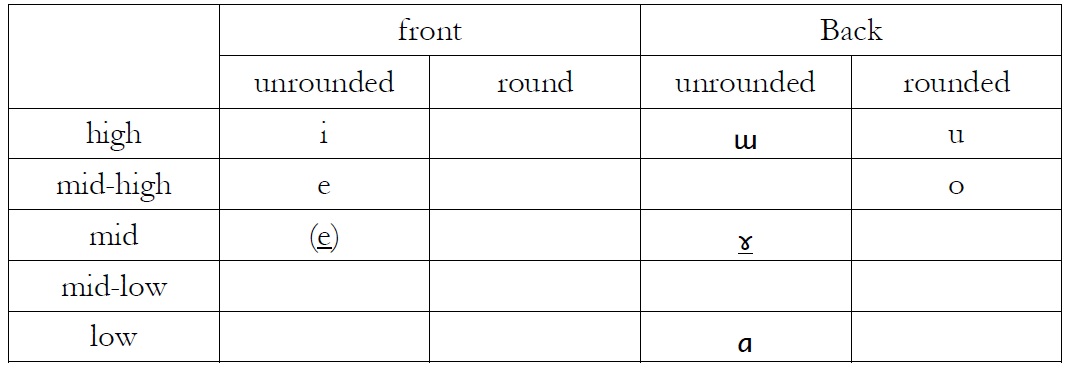
YK: Seven-vowel system
In this system, as mentioned above, the two vowels /e/ and / ɛ / are neutralized to either mid-high vowel /e/ or mid vowel /e/. This system has an equal number of front and back peripheral vowels with one low-peripheral vowel, and two interior vowels at back. Though this system is not recognized as a variation of the standard pronunciation of Korean, it is the most common variation of the modern Korean vowel systems regardless of age and region in South Korea except in the southeast region (cf. (4)).9 In fact, it is difficult to find people under sixty years of age who distinguish these two vowels. For example, the words /kɛ/ “dog” and /ke/ “crab” are not distinguishable except among the very old generation.
There is another system that is valid only in the southeast region in the Korean Peninsula. This system (henceforth, SK) consists of five peripheral vowels (two each at front and back, and one low), with one back interior vowel / ɯ /, as shown in (4) below. In this system, the vowel /ɤ/ is merged with the / ɯ /.
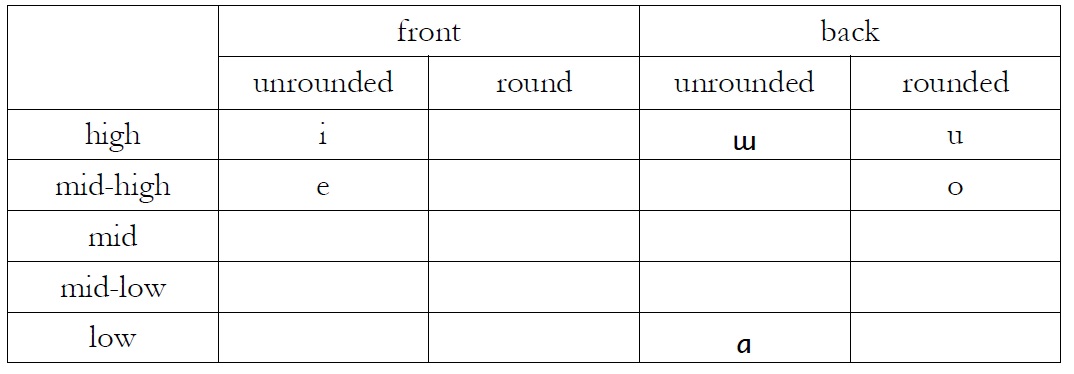
SK: Six-vowel system
So far we have discussed the systems spoken in South Korea. There is one initiative system (CK) with a ten-vowel system and two OK systems, each with a nine-vowel system. We also have YK with a seven-vowel system and SK with a six-vowel system. Over time, the vowel systems of South Korean are evolving from the ten-vowel system to a seven-vowel system via nine-vowel systems.
On the other hand, North Korea has two variations (NK1 and NK2) of vowel systems according to age group. Some phonologists (Bae, 2003; Kwak, 2003; Cho, 2005) assume that the system NK1 spoken by the elderly group has eight vowels, /ɑ, i, u, e, o, ɛ , ɯ, ɤ/, as in (5) below.
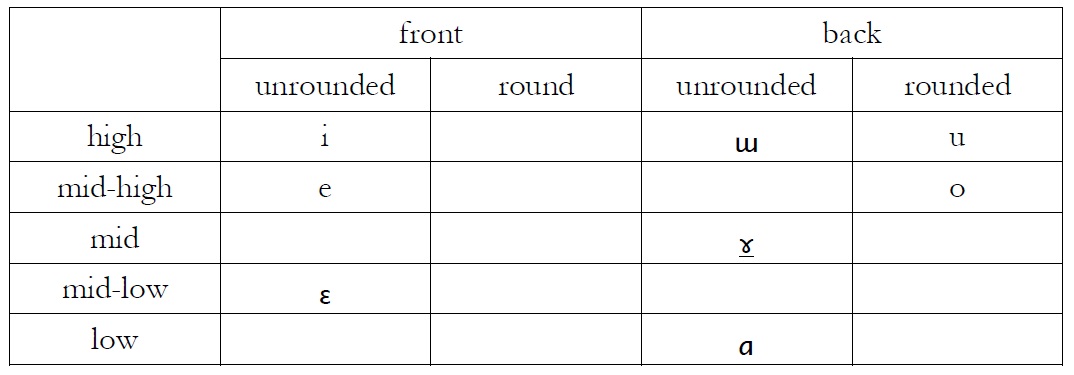
NK1: Eight-vowel system
This system contains six peripheral vowels as in the ten-vowel system, but the two front interior vowels, /y/ and /ø/, have disappeared. This system is also recognized as a variation of the standard pronunciation of Korean vowels. However, this system is regarded as a kind of transition system from the tenvowel system to the seven-vowel system, and thus has almost disappeared, just like CK (ten-vowel system), at least in South Korea.10
In contrast, NK2 spoken by the young group is a six-vowel system consisting only of peripheral vowels / ɑ , i, u, e, o, ɛ /, as in (6) below.

NK2: Six-vowel system
As can be seen in (6), the vowel systems of Korean dialects are certainly not as diverse as those of other large countries, such as China, but they are various, considering its regional size, having seven different systems (CK, OK1, OK2, YK, SK, NK1, and NK2). What we find through the evolution of the systems is a down-sizing in the number of vowels. That is, the ten-vowel system became the seven-vowel system via the nine-vowel system in South Korean, and the eightvowel system became the six-vowel system in North Korean, in line with the newer generations. The only exception is SK, which is believed to have a separate system.
There are two main points and some minor points in the evolution of South Korean vowel systems. The two main points are (i) whether or not the two front rounded vowels, /y, ø/, are allowed to appear in the system, and (ii) whether or not the two front non-high peripheral vowels, /e/ and / ɛ /, are merged into a single vowel. Simply put, the major trends of the evolution of Korean vowel systems are the loss of /y/ and /ø/, and a neutralization of /e/ and / ɛ /.
We also have to mention some minor points that are unique to particular regions. First, in the SK spoken in the southeast region, the vowel /ɤ/ is merged with the / ɯ /, as in (4). Second, the fact that the older generation in Jeju Island uses the vowel / ɔ / as well as /o/ is very unusual in Korean vowel systems, because only one non-high back peripheral vowel is allowed in other systems. Third, the system (6) spoken by the younger generation in North Korea is another case of divergence from the norm in terms of its lack of interior vowels. We assume that these divergences are partially because these regions have been in prolonged separation and isolation because of geographical and sociolinguistic or cultural barriers.
2.2. BASIC CONCEPTS OF ELEMENT THEORY
The representational system for segments in GP differs from that of other theories in many ways. All phonological segments are composed either of elements or a fusion of elements.11 The element is the primitive phonological unit, and it contains a salient property. Elements A, I, U are proposed for the vowels (as well as for the consonants), and the basic speech sounds /a, i, u/ are phonetic realizations of each element, as shown (7) below.

Elements for vowels
Languages having five vowels mainly consist of the above three vowels and the two additional vowels /e, o/ (Crothers, 1978; Maddieson, 1984; Schwartz, Boë, Vallée, & Abry, 1997), and, as is well known, this system is the most prevalent pattern in human languages. The additional two vowels are expressed by the combination of elements. Fusing A with I results in /e/, and A with U results in /o/. Again, this system is the most widespread one in the world, and thus it can be said that the vowels in this system are maximally dispersed from each other. According to GP expression, this system has three simplex vowels consisting of a single element, and two compound vowels consisting of two elements, one of which is A, as in (8) below.
The regularity of vowel patterns that is revealed through three- and five-vowel systems is one of the main topics that every phonological theory ought to explain. Several versions of the dispersion theory (Lijencrants & Lindblom, 1972; Flemming, 2004)12 also attempt to explain these patterns, with the basic notion that vowels tend to be evenly distributed in the available phonetic space and also widely distributed within the limitations of a particular system (Disner, 1984). There are differences between the element theory and the dispersion theory in the sense that while the latter uses the notion of “space dividing” itself, the former pulls the notion into the phonology and can account for it in a principled way using the elements. Notice that the element theory makes the notion of “building up segments in an ordered fashion” a theoretical reality, as can be seen in its explanation of compound vowels.
In the following section, we will analyze the variations of Korean vowel systems in the course of explaining dependency relations between elements.
5We accept the definition of peripheral given by Schwartz, Boë, Vallée, and Abry (1997). They define three groups of peripheral vowels: (i) Front peripheral vowels—all front unrounded vowels from /i/ to /æ/; (ii) back peripheral vowels—all back rounded vowels from /u/ to / and (iii) low peripheral vowels—a broad low-peripheral region including all vowels in the set / ɐ a + a ɑ /(i.e., vowels lower than those belonging to the front or back peripheral sets). 6Strictly speaking, the utterance with [ɤ:] is much more common. 7According to Kwak (2003), this vowel exhibits various regional pronunciations such as [ə], [ ɜ ], [ʌ], [ɔ], etc. 8We would like to note that two non-high back peripheral vowels can only be seen in the system of OK3. 9Note that Kim and Heo (1999) have discussed the seven-vowel system of Korean based on the licensing constraints of GP. 10According to Kim (1996), if a speaker has the two front round vowels, he also distinguishes the two front unrounded vowels, and if a speaker does not have the two front round vowels, the front unrounded vowels are neutralized. For this reason, she claims that an eight-vowel system is not necessary for consideration as a variation of South Korean vowel systems. 11For a detailed discussion on element theory, see Kaye, Lowenstamm, and Vergnaud (1985); Harris (1990, 1994); and Harris and Lindsey (1990, 1995, 2001). For the application of GP in Korean phonology, see Heo (1994); Kim (1996); and Rhee (2002). 12See Vaux and Samuels (2006) for more references on various versions of dispersion theory.
3. ANALYSIS OF KOREAN VOWEL SYSTEMS
According to Crothers (1978), the most common seven-vowel systems have either / ɛ , ɔ / or / ɨ , ə / in addition to the five vowels in (8) above, yielding /a, i, u, e, o, ɛ , ɔ / or / a, i, u, e, o, ɨ , ə /. Out of forty-four seven-vowel languages in UPSID317 , twenty-three languages fall into the former type, and six languages fall into the latter type (Schwartz, Boë, Vallée, & Abry, 1997). Let us consider the vowels / ɛ , ɔ / first. GP claims that these two vowels are defined by assuming that fusion involves some kind of dependency relation between elements of a compound. In this relation, one element plays a head of the compound, and the other element(s) is presented as a dependant(s). We can have the following two A-I compounds, as in (9a and b) below, and two A-U compounds, as in (9c and d) below, where the head element is underlined.
In the asymmetrical relations (9) above, the representations with A-head are defined as vowels that are lower than those with non-A-head, such as those (10) below.
Let us now consider Korean vowel systems. Though the vowel systems of South Korea show a trend of merging the two vowels /e/ and / ɛ / into /e/(or /e/), there are systems such as CK with a ten-vowel system and the OK2 (of Jeju Island) with a nine-vowel system, which still distinguish the two vowels as being separate. What is observed is that both representations in (9a) and (9b) are allowed in these systems, which allow two non-high peripheral front vowels /e/ and / ɛ /; whereas, the representation (9b) is not allowed in the systems that allow only one non-high peripheral front vowel /e/.
The question is why South Korean allows system shifts from the ones with / ɛ / to the ones without. One could argue that the system shift results in a wellarranged system in the sense of dispersion. That is to say, having three peripheral vowels at front but two peripheral vowels at back is asymmetric or skewed, thus, requiring certain types of complementary behavior for a balanced system. They could argue with dispersion theory that losing a front peripheral vowel is the result of an adjustment of the unbalanced system. In other words, the adjusted new systems, such as the YK seven-vowel system, in which /e/ and / ɛ / are neutralized, can now be said to be well spaced by having two vowels each at the front and back peripheral spaces.
However, the problem with this kind of account is that the same shift cannot be found in the course of evolution from NK1 to NK2; both of which seem to have skewed peripheral vowels at front and back.
We see that there are counterexamples against the dispersion theory. For instance, it is claimed that dispersion theory cannot properly explain the fact that the systems with /i, e, a, u/ are favored over the systems with /i, a, o, u/ (Vaux & Samuels, 2006). Notice that both systems are equally dispersed, and thus they should be equally favored, as Joanisse and Seidenberg (1998) pointed out. In fact, it is revealed that the systems with more peripheral front vowels (fifty-one languages) are much more common than the systems with more peripheral back vowels (fourteen languages), according to the work of Schwartz, Boë, Vallée, and Abry (1997) who analyzed the primary and secondary UPSID317 vowel systems in terms of their number of vowels, their peripheral structure, and non-peripheral complementary vowels. Considering the shape of the human mouth and the upand-down movement of the jaw, it is very natural to have more vowels in the front periphery, which can open wide, than in the back periphery, as shown in (11) below, where the vowel spaces of Korean and English, which are plotted in the F1-F2 plane, are illustrated.13
By the same token, the arguments of Joanisse and Seidenberg (1998) that the /i/~/e/ contrast is easier than the /u/~/o/ contrast because of the genioglossus muscle, and that the system with the easier-to-distinguish contrast is more likely to be learned successfully, which results in a front-heavy system being favored crosslinguistically (Vaux and Samuels, 2006), are quite plausible. We cannot say that the systems with asymmetrical peripheral vowels are not well balanced and thus deserve to be changed to be evenly dispersed. We also reject the claim that having the same number of vowels at front and back peripheral spaces is evenly and maximally dispersed.
As for the neutralization of the non-high front peripheral vowels of Korean, we would like to claim that this process is not a matter of the dispersion or adjustment of an unbalanced system, but rather that it is a matter of whether the system allows two different dependency relations between the same elements in compound vowels as in (9). There is a trend in South Korean of not allowing the two dependency relations, whereas such a trend cannot be found in North Korean during its evolution. For this reason, although initiative systems of South and North Korean equally have two non-high front peripheral vowels, YK, with a seven-vowel system in South Korean, has lost one of them, whereas NK2, with a six-vowel system in North Korean, still keeps both of them.
The two nine-vowel systems serve as additional evidence for this claim. What we see from these two systems is that the two non-high front peripheral vowels are available only when the system has the counterparts at back. In other words, if the system allows two different dependency relations at back then it has two nonhigh peripheral vowels at front as well as back, and if the system does not allow such relations at back then only one non-peripheral vowel is available, not only at back but also at front. The system OK2, where /e/ and / ɛ /, and /o/ and / ɔ / are present, is an example of the former, and OK1, in which only front vowels /e/ and /o/ are available, can be an example of the latter. Korean vowel systems are now undergoing a change toward a prohibition of having two different dependency relations.
More concretely, we claim that Korean shows a tendency to have a constraint that does not allow non-high front and back peripheral vowels in which the element A plays the role of head. Thus, segments having the following representation are excluded from the list of Korean vowels.
Let us now consider whether the same constraint is applicable for the case of SK with a six-vowel system. We claim that the fact that the disappearance of /ɤ/ from the seven-vowel system by the neutralization of it to / ɯ / is again the result of the constraint that the system does not allow the two different dependency relations. We assume that the representations of these two vowels are the same as those of / ɨ / and /ə/, respectively. We assume that no languages have the two vowels, / ɯ / and / ɨ /, or /ɤ/ and /ə/, together in their phonological inventories, for the reason that they are respectively phonetically too close.14 As is well known, these vowels alternate with zero in many languages. For instance, the vowel / ɨ / (i.e., / ɯ / in this paper) alternates with zero in Korean (Heo, 1994), and it is the vowel /ə/ that alternates with zero in French (e.g., Charette, 1991). In GP, these vowels are defined as the neutral element @ having no salient property.15 Notice that the vowel / ɨ / (or / ɯ /) has none of the salient properties of A (lowness), I (frontness), or U (roundness).
We can find that the representation of /ə/ (or /ɤ/) has the same elements as /a/ (or / ɑ /) but is different in headship.16
The fact that representation (13b) is not allowed in SK with a six-vowel system means that the system allows only one among the representations to have the same elements but different headship. Again, there are no two vowels that have the same elements but are different in headship in this pattern of a six-vowel system of Korean. In this situation, it appears that the SK system of Korean illuminates the one in (13b). The reason why it is (13b) not (14) that undergoes illumination is simply because (14) is the representation of /a/ (or / ɑ /). Although (14) has the element A as a head, it is the most important peripheral vowel in the human language; thus, it is hard to get rid of it from the list of vocalic segments.
We can now have general aspects of languages that have an equal number of front and back peripheral vowels with one compulsory low vowel according to their constraints, as in (15) below.
[(15)] Vowel systems according to the constraints on peripheral vowels

Vowel systems according to the constraints on peripheral vowels
We now face the questions of how and why the system YK, having seven vowels, contains / ɑ / and /ɤ/, both of which contain the same elements as in (13b and 14) above, if Korean has the trend of not allowing two different dependency relations and thus one of the two vowels is not present even in a sixvowel system. To answer these questions, we assume that the seven-vowel system is also now undergoing certain kinds of evolution. Recall that the phonetic space of the vowel /ɤ/ ranges from mid-high [ɤ:] to [ʌ], or [ɔ] according to its length. When it is [ɤ:], it is realized as [ɯ] in most cases in daily life. This means that [ɤ:] is almost neutralized to / ɯ /, even now, and will perfectly merge in the near future. The situation is slightly different when the vowel is short. The phonetic realization of this short vowel is still [ʌ] in many places in Korea. This means that this vowel still keeps its own quality when it is short. However, there are some regions where this vowel is pronounced as [ɔ]. If this process spreads to the entire nation, the vowel will finally neutralize with /o/, because [ɔ] is a phonetic variant of /o/ in Korean. As for this, Kwak (2003) has also mentioned the possibility of a system shift from a seven-vowel system to a six-vowel system.
Kwak’s argument differs from ours in its proposed reason for the system shift; he attributes the system shift to the asymmetry of the seven-vowel system. He claims that the YK system of Korean has a 2║3-2 configuration that is skewed, and thus could change to a well-balanced six-vowel system such as the SK system, which has the configuration of 2║2-2.17 The two systems shown in Kwak (2003) are given in (16) below:
However, we do not see why the system (16a) is asymmetrical, because the system is a well-spaced system that has five peripheral vowels consisting of an equal number of front and back vowels with one low vowel, and two interior vowels. As mentioned above, this system is the second richest system out of the nine seven-vowel systems. For this reason, Kwak’s opinion that the system (16a) above is asymmetrical and thus deserves to be changed to (16b) cannot be acceptable. We claim that the reason for the neutralization of back interior vowels is due not to the asymmetry of the seven-vowel system but to the refusal of two different dependency relations.
Let us now finally consider the two front interior vowels, /y/ and /ø/. These vowels are visible only in two systems, namely CK and OK1. This means that these two vowels have almost disappeared from the list of Korean monothongs. As mentioned above, they are pronounced either as diphthongs or vowels with no roundness. For these phenomena, we claim that Korean has a trend of avoiding the combination of the two elements I and U. Actually, the fusion of I with U is not so preferred universally, simply because the combination of two properties, frontness and roundness, is far from the so-called economy of pronunciation. As Crothers (1978) has mentioned, the front vowels are generally unrounded because this leads to a higher F2 and F3, which are high for front vowels; back vowels are generally rounded because this causes a lower F2, which is already low for them. In other words, rounding reinforces the backness of back vowels, and unrounding reinforces the frontness of the front vowels (Fant 1973: 186ff.). Based on the claims of Fant (1973) and Crothers (1978), we can reconfirm the fact that human languages cannot help having a relatively small number of front interior vowels, and many languages, in particular languages with a small number of vowels, do not allow such vowels to come into their vowel inventories. It is reported in UPSID317 that twenty-one languages have the vowel /y/ and fifteen languages have the vowel /ø/, and Korean is included in both these groups of languages. Based on this, it is not unnatural that Korean, which is down-sizing its phonetic members, eliminates the vowels in question from the monophthong. The processes of the derivations of [y] → [wi] → [i], and [ø] → [we] → [e] are illustrated (17) below:
13The pictures shown below are replotted from Yoon’s (2010) tokens for vowel formant frequencies in Bark-difference dimensions to the raw frequency in Hertz. 14According to Maddieson (1984), only two languages, Nimboran and Bashkir, are exceptions to this assumption. Nimboran has / ɯ / and / ɨ /, and Bashkir has /ɤ/ as well as /ə/. The fact that Nimboran has no /u/ implies that / ɯ / of this language may be different from that of other languages. 15See Harris (2004) for a detailed discussion on the element @. 16It should be noted that @ contributes nothing to the representation in which it occurs as a dependant; thus, the representation (13b) is not different from the representation that consists of the sole element A. 17The symbol ║ is a mark for the boundary for front vs. back vowels, and the numbers on the left refer to the numbers of front unrounded vowels, and the numbers of the first and second rows on the right respectively refer to the numbers of back unrounded and round vowels.
So far we have discussed the various vowel systems of Korean that are seen in the course of diachronic changes. Korean vowel systems differ one from another mainly on (i) whether or not the two non-high front peripheral vowels undergo neutralization, and (ii) whether or not the system allows the two front interior vowels. The main flow of the Korean vowel system shift is toward reducing the number of vocalic items. Thus, the number of vowels is decreasing from ten to seven, or even to six. That is, a front peripheral vowel and the two front interior vowels have disappeared from the vocalic list in six- and seven-vowel systems.
As for this evolution of Korean vowel systems, we claim that it is not caused by the problem of space division, which violates the principle of vowel dispersion, but rather by the tendency of the constraint that Korean does not allow two different dependency relations between the elements contained in a segment. More concretely, the constraint that A-head non-high front and back peripheral vowels are not allowed is emerging as a trend in Korean phonology. In addition, there is also a trend in Korean to have the constraint whereby the two elements I and U are not allowed to be fused. The former excludes a vowel from the front peripheral space, and it is because of the latter that the two vowels /y/ and /ø/ are not present in the list of Korean vowels. However, whether or not the trend of not allowing two different dependency relations applies to the (back) interior vowels cannot be fully assured, because the seven-vowel system, which is widespread across the country, is considered as being solid for the time being. Thus, the conclusion that the vowel /ɤ/ will undergo neutralization in the near future cannot be easily made, even though its status is somewhat unstable.

